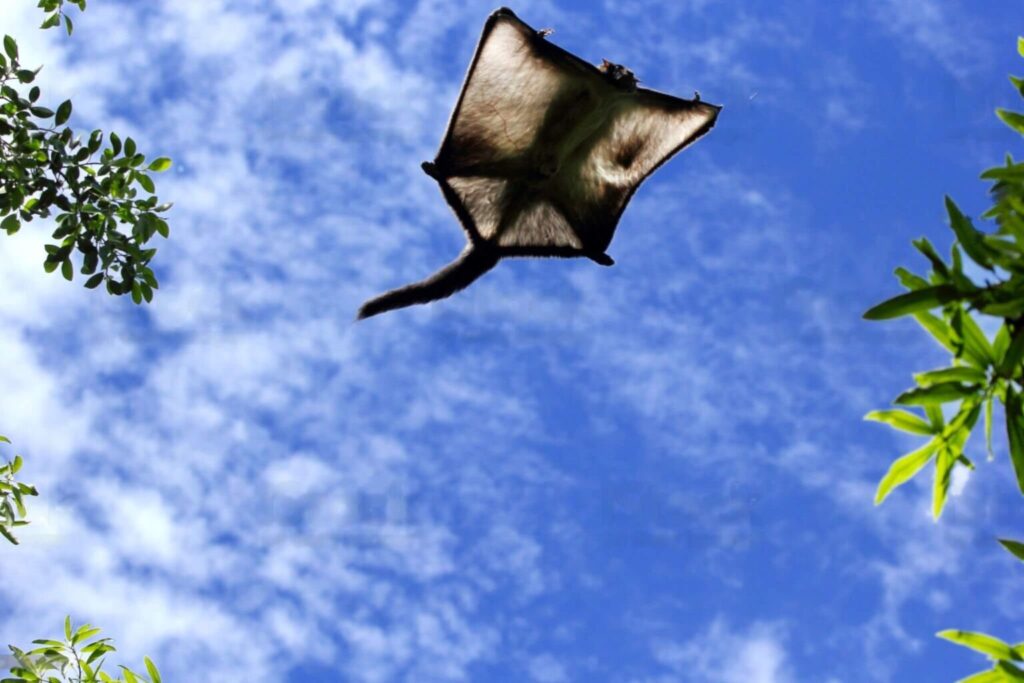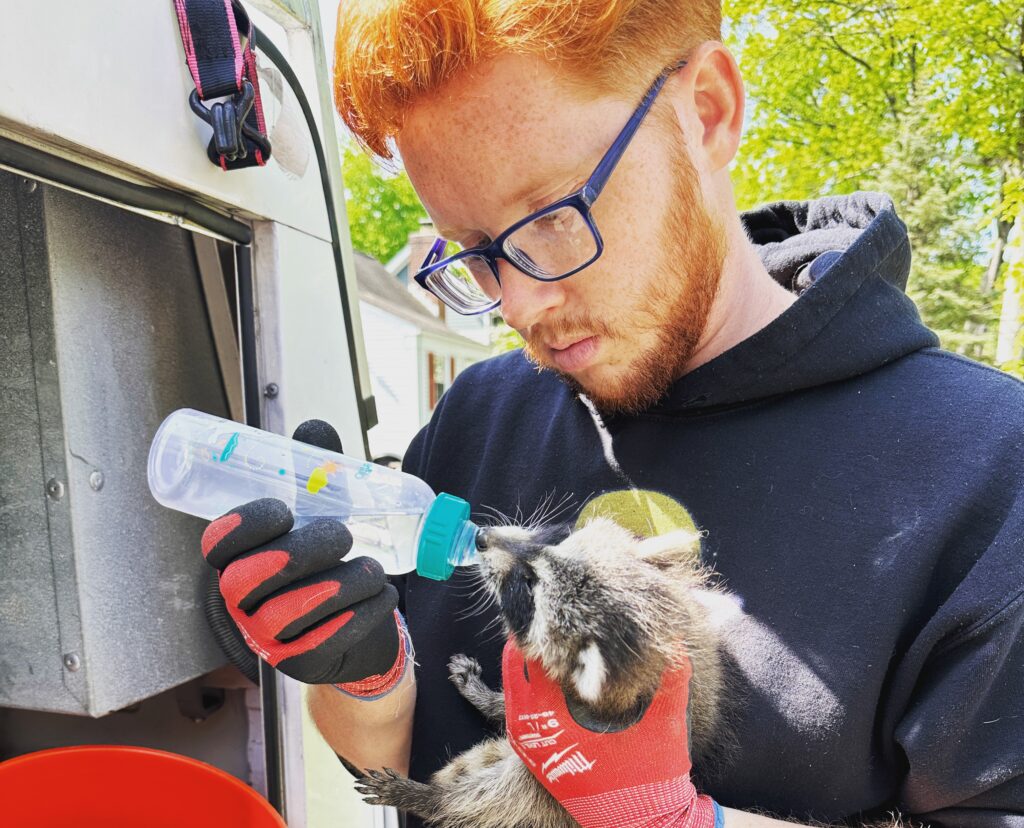New Jersey is home to a unique and fascinating creature: the flying squirrel. Contrary to their name, these nocturnal mammals don’t actually fly but glide between trees using a membrane called a patagium. In New Jersey, the most common species is the Southern Flying Squirrel, a small, nimble creature known for its large, expressive eyes and nocturnal habits.
Identifying flying squirrels in your home is crucial for coexistence. Homeowners often hear soft scurrying or scratching sounds in their attics at night. Look for small, round droppings or signs of nesting in insulation. These signs indicate the presence of flying squirrels.
Key Takeaways
- Understanding flying squirrel habits is crucial for coexistence.
- Modifying your attic and using natural deterrents can discourage squirrels.
- Opt for humane removal methods to address challenging situations.
- Regularly inspect and address potential entry points to prevent infestations.
- Professional services like Kritter Catchers offer ethical solutions for wildlife management.
The Impact of Flying Squirrels on New Jersey Homes
Understanding the Intricacies of Squirrel Behavior
Flying squirrels, while enchanting in their natural habitat, can pose unique challenges when they inhabit New Jersey homes. These nocturnal creatures, active primarily at night, can disrupt the tranquility of a household with their nocturnal activities. Their movements within wall cavities and attic spaces often create unsettling noises that can disrupt sleep and cause unease.
Assessing the Structural Impact
The presence of flying squirrels in homes goes beyond mere noise disturbance. These agile creatures have a natural tendency to gnaw, which can lead to significant structural damage. They often chew on wooden beams, insulation, and even electrical wiring. The latter poses a severe risk, potentially leading to electrical shorts and increasing the likelihood of fire hazards. Additionally, their nesting activities can compromise the integrity of insulation, leading to energy inefficiencies and increased heating or cooling costs for homeowners.
Health and Hygiene Concerns
Another critical aspect to consider is the health and hygiene implications of flying squirrel infestations. Their droppings and urine can accumulate in attic spaces or wall cavities, potentially leading to unpleasant odors and unsanitary conditions. Moreover, these waste products can harbor pathogens and contribute to poor indoor air quality, posing health risks to residents, especially those with allergies or respiratory issues.
The Unseen Environmental Impact
On a broader scale, the displacement of flying squirrels from their natural habitat to urban homes can have unintended environmental consequences. These squirrels play a crucial role in seed dispersal and maintaining the ecological balance in forests. Their forced adaptation to urban environments can disrupt local ecosystems and biodiversity.
Long-Term Implications for Homeowners
The long-term implications for homeowners dealing with flying squirrel infestations can be extensive. Not only do they face immediate concerns such as noise, damage, and health risks, but there are also potential long-term financial implications. The costs associated with repairing structural damage, replacing insulation, and addressing electrical issues can be significant. Furthermore, homes with a history of wildlife infestations can face challenges in maintaining property values and might require ongoing monitoring and preventive measures to ensure the problem does not recur.

Effective Strategies for Coexisting with Flying Squirrels
Adopting a Proactive Approach
Coexisting with flying squirrels requires a proactive and informed approach. Understanding their behavior and natural needs is key to developing effective cohabitation strategies.
Enhanced Humane Removal Techniques
While initial efforts should focus on humane removal and exclusion, it’s important to employ a multi-faceted strategy:
- Use of One-Way Exclusion Doors: These doors are designed to allow squirrels to leave your home but prevent them from re-entering. It’s a humane method that doesn’t harm the animals.
- Sealing Entry Points: After the squirrels have vacated, it’s crucial to seal all potential entry points. This includes small gaps in the roof, eaves, and soffits. Use sturdy materials like metal flashing or hardware cloth, as squirrels can easily chew through softer materials.
Creating a Hospitable Outdoor Environment
Encouraging flying squirrels to stay outdoors is beneficial for both the animals and homeowners:
- Installing Squirrel Nest Boxes: By providing alternative nesting options like specially designed squirrel boxes, homeowners can offer a safe habitat for these creatures away from their homes.
- Providing Natural Food Sources: Planting native trees and shrubs that produce nuts, seeds, and fruits can help sustain the squirrels in their natural habitat, reducing their need to seek food in human dwellings.
Integrating Technology and Nature
Leveraging technology can enhance cohabitation strategies:
- Motion-Activated Lights: Installing these lights can deter nocturnal squirrels from approaching your home, as they are sensitive to sudden changes in lighting.
- Wildlife Cameras: These can help monitor squirrel activity around your property, allowing for a better understanding of their habits and movements.
Community Engagement and Education
Understanding and coexisting with wildlife is a community effort:
- Engage with Local Wildlife Experts Kritter Catchers: Seek advice from local wildlife conservation groups or professionals for specific guidance and educational resources.
- Share Knowledge: Educate your neighbors about flying squirrels and the importance of coexistence. Community-wide efforts can lead to more effective and humane management strategies.
Enhanced Preventative Measures for New Jersey Homeowners Against Flying Squirrel Infestations
Preventing flying squirrel invasions in New Jersey homes requires a comprehensive approach that encompasses various strategies. Regular home inspections are crucial, with a focus on identifying and repairing potential entry points such as gaps in the roof, eaves, soffits, and around vents and chimneys. Ensuring these areas are secure with sturdy materials like metal flashing or high-quality sealants is essential.
Maintaining the exterior of the house is also key. This includes repairing any damaged wood or siding that could provide access to these agile creatures. The role of landscape management cannot be overstated. Homeowners should keep tree branches trimmed, especially those close to the house, as flying squirrels often use them to glide onto roofs. Cleaning up any food sources, like fallen nuts or fruits, reduces the property’s attractiveness to these animals.
Implementing squirrel deterrents can complement these efforts. Motion-activated sprinklers and ultrasonic repellents can be effective, although they should be part of a broader strategy rather than standalone solutions. Encouraging natural predators also plays a role in controlling flying squirrel populations. Installing owl boxes and preserving natural habitats for predators like owls can help maintain a natural balance in the ecosystem.
Educational awareness is vital. Understanding the behavior and seasonal patterns of flying squirrels can aid in anticipating and preventing infestations. Moreover, engaging with the community for collective efforts can enhance the effectiveness of these prevention strategies. Regular reassessments of the home and property are necessary to identify new potential vulnerabilities, and homeowners should be ready to adjust their strategies based on the effectiveness of current measures and any changes in flying squirrel behavior.
FAQs
What are flying squirrels and how can they be identified?
Flying squirrels are a species of squirrel known for their ability to glide between trees. They are smaller than regular squirrels, with large eyes and a membrane stretching between their front and hind legs. In New Jersey, they are mostly nocturnal.
How do flying squirrels enter homes?
Flying squirrels usually enter homes through small openings or gaps in the roofline, eaves, soffits, vents, and chimneys. They are attracted to attics as they provide a warm and safe environment for nesting.
What kind of damage can flying squirrels cause in a home?
They can cause structural damage by gnawing on wood and electrical wires, which poses a fire hazard. Their nesting can also lead to insulation damage and their droppings can create hygiene issues.
Are flying squirrels dangerous to humans?
Flying squirrels are not typically dangerous to humans. However, their droppings and urine can pose health risks, especially in cases of large infestations, and they can cause allergies or respiratory issues.
How can I prevent flying squirrels from entering my home?
Preventive measures include sealing potential entry points, maintaining the exterior of your home, managing your landscape to remove food sources and access points, and using deterrents like motion-activated lights.
Harmonious Coexistence Is Possible
Living with flying squirrels in New Jersey can be a harmonious experience. By understanding their habits, taking preventive measures, and using humane exclusion techniques, homeowners can effectively manage their presence. Remember, these creatures play a vital role in our ecosystem, and coexisting with them contributes to the rich biodiversity of New Jersey.


